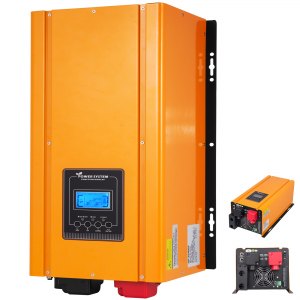The concept of connecting the neutral to protestive earth cable when using an inverter, to ensure that a RCD will function, is difficult to digest at first.
Consider for a moment the shore supply for 230AC outlets in your van. Due to the higher risk where electricity is used in an outdoor situation, the regulations require a double pole RCD and MCB at the campsite supply bollard and a second set of RCD/MCB in your van. At the supply bollard the neutral conductor is bonded (connected) to the protective earth conductor and also connected to the power station 'ground' the dirt. Once the supply is in the van, the van metal work is connected to the protective earth cable, the green/yellow cable.
You are now protected against an over current fault by the double pole RCD ( there are effectively 2 in series in case one fails to operate).
If there is any fault with the electrical equipment inside the van such that current flows through equipment to 'ground' ( the van shell and any metal appliance in now the 'ground') due to a fault or through a person, over 30mA, the RCD will trip. Again you have 2, so if one fails to function there is a backup.
The RCD that protects you against electric shock will only work when connected to shore power, if all the following conditions are met,
a) there is a 'bond' at the supply bollard where the neutral wire is connected to the earth protective conductor and a connection to ground earth, the dirt.
b) the protective earth conductor ( green and yellow wire) is connected to the van metal and via the connections and the internal cables to any metal appliance or metallic parts of the heating, cooking and water system that are 230AC powered.
When you are disconnected from shore power and using a permanently installed inverter you are effectively setting up your own power station.
Thus to meet the requirements for the RCD to operate down stream of the inverter, you have to meet the requirements a) and b).
Now a) and b) are a bit easier to implement because the 'dirt' earth can be the van metal, but at the inverter, the protective earth cable must be connected to the neutral cable and to the inverter casing and to van metal. Inverters sold by reputable companies for a permanent install will either have this 'bond' already in place or have provision for doing so. Not all inverters can be connected this way.
Life can be more complicated when the inverter incorporates autochanger and/or charging facilities. In this case the inverter package or some additional equipment must look after the neutral to protective earth bond inside the van. The rules are simple, when connected to shore power the neutral to earth bond is at the supply bollard and the inverter bond is open circuit. With no shore power connected the neutral bond at/in the inverter is closed.
What must not happen is both bonds being active at the same time. Should a 'bond' in the van and a 'bond' at the supply point, be active at the same time, not only is this dangerous, as very high voltages can develop with certain faults in the power distribution system, its also illegal, the going to jail kind.
There is no indication with the limited info on the inverter you are considering, that it looks after this neutral to earth bonding. It may be there but I suspect not.
There are a number of points you make in you post that are incorrect and/or unsafe.
inverter chassis will be screwed/bolted to 25mm (1 inch) plywood, which isolates the inverter from the vehicle body.
This is against advice from every inverter installation manual in existence. The inverter chassis must be connected to the van metal, the 230 AC protective earth and the battery negative. Ideally the cable from the case should be one size down from the cables carrying power from the battery to inverter.
i understand the inverter needs to be grounded to a true earth when its not connected to shore power but there are tens of thousands of inverters that connect the earth/ground to the vehicle chassis which is a false earth. In effect making the vehicle body live with 110v-240v if there was an electrical fault.
Dont fully understand the point you are making.
My points, when away from shore power the van metal should become your 'earth', 'ground' or whatever you wish to call it.
If fault occurs that attempts to make the van live, protective circuits in the inverter or a RCD fitted after the inverter or the fuse/breaker on the inverter input will trip, thus voltage will never appear on the van metal. If there is no connection between the inverter case and the van metal, an internal fault in the inverter that made the case live would not be detected.
If the neutral connection to earth conductor to van metal was not in place the RCD would not work.
dont have any bare metal inside the van that i can physically touch.
unless you connect the protective earth of your 230v AC to the van metal there is a risk for you inside the van, or anyone outside the van.
Mike



